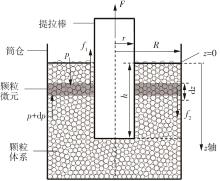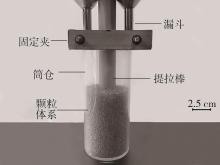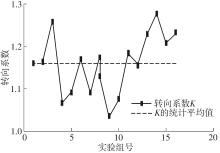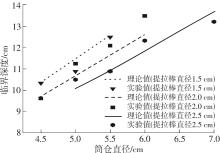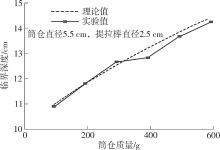| 1 |
陆坤权,刘寄星 .颗粒物质(上)[J].物理,2004,33(9):629-635.
|
|
LU Kun-quan, LIU Ji-xing .Static and dynamic properties of granular matter (Ⅰ)[J].Physics,2004,33(9):629-635.
|
| 2 |
丁小彬,施钰,陈俊生 .基于三维离散元的大直径钢圆筒下沉侧摩阻力[J].华南理工大学学报(自然科学版),2020,48(4):15-27.
|
|
DING Xiaobin, SHI Yu, CHEN Junsheng .Side friction of large-diameter steel cylinder simulated using 3D discrete element method[J].Journal of South China University of Technology (Natural Science Edition),2020,48(4):15-27.
|
| 3 |
张兴刚,戴丹,汤燕 .单分散圆盘堆积的Voronoi统计模型[J].华南理工大学学报(自然科学版),2023,51(2):122-130.
|
|
ZHANG Xinggang, DAI Dan, TANG Yan .Statistical Voronoi model for monodisperse disk packings[J].Journal of South China University of Technology (Natural Science Edition),2023,51(2):122-130.
|
| 4 |
李湘群,蒋亦民,彭政,等 .Rankine被动应力状态粮仓的Janssen行为[J].山东大学学报(理学版),2010,45(9):101-105.
|
|
LI Xiang-qun, JIANG Yi-min, PENG Zheng,et al .Janssen behavior of a grain silo in a Rankine passive stress state[J].Journal of Shandong University (Science Edition),2010,45(9):101-105.
|
| 5 |
王璐珠,蒋亦民,彭政,等 .非Jaky粮仓的弹性应力分析和侧壁边界条件[J].科学通报,2011,56(14):1091-1096.
|
|
WANG Luzhu, JIANG Yimin, PENG Zheng,et al .Boundary condition and elastic analysis of stress for silos without Jaky property[J].Scientific Bulletin,2011,56(14):1091-1096.
|
| 6 |
胡林,杨平,徐亭,等 .颗粒物质中圆棒受到的静摩擦力[J].物理学报,2003,52(4):879-882.
|
|
HU Lin, YANG Ping, XU Ting,et al .The static friction force on a rod immersed in granular matter[J].Acta Physica Sinica,2003,52(4):879-882.
|
| 7 |
孔维姝,胡林,杜学能,等 .用探测棒研究颗粒堆中的最大静摩擦力[J].物理学报,2007,56(4):2318-2322.
|
|
KONG Wei-shu, HU Lin, DU Xue-neng,et al .Studies of maximum static friction force in granular pile with probing rod[J].Acta Physica Sinica,2007,56(4):2318-2322.
|
| 8 |
白光富,胡林,张忠政,等 .小筒仓内颗粒中探测棒受到的最大静摩擦力[J].力学与实践,2009,31(4):64-68.
|
|
BAI Guangfu, HU Lin, ZHANG Zhongzheng,et al .Static friction force on probing rod in granular pile in small container[J].Mechanics and Practice,2009,31(4):64-68.
|
| 9 |
李智峰,彭政,蒋亦民 .粮仓内颗粒压力的测量:Janssen行为及其偏差[J].物理学报,2014,63(10):296-303.
|
|
LI Zhi-feng, PENG Zheng, JIANG Yi-min .Measurements of granular pressure in silo:Janssen behaviour and deviation[J].Acta Physica Sinica,2014,63(10):296-303.
|
| 10 |
冯云田,华云龙 .适用于柔性圆筒仓的修正的Janssen公式[J].中国农业大学学报,1996,1(4):107-111.
|
|
FENG Yuntian, HUA Yunlong .Modified Janssen formula for flexible circular bins[J].Journal of China Agricultural University,1996,1(4):107-111.
|
| 11 |
THORENS L, MÅLØY K J, BOURGOIN M,et al .Magnetic Janssen effect[J].Nature Communications,2021,12(1):2486/1-6.
|
| 12 |
MAHAJAN S, TENNENBAUM M, PATHAK S N,et al .Reverse Janssen effect in narrow granular columns[J].Physical Review Letters,2020,124(12):128002/1-5.
|
| 13 |
陈喜山,朱卫东 .Janssen公式的拓广与应用[J].土木工程学报,1996,29(5):11-17.
|
|
CHEN Xishan, ZHU Weidong .Extension and application of Janssen equation[J].Journal of Civil Engineering,1996,29(5):11-17.
|
| 14 |
郑甲红,明磊,马浩然 .基于Janssen模型的扦样管受力分析与试验[J].粮食储藏,2022,51(5):9-12.
|
|
ZHENG Jiahong, MING Lei, MA Haoran .Stress analysis and experiment of sampling tube based on Janssen model[J].Grain Storage,2022,51(5):9-12.
|
| 15 |
周新雅,周行,蔡孝文 .基于教材“筷子提米”实验的科学探究与教学实践[J].中学物理教学参考,2018,47(19):66-67.
|
|
ZHOU Xin-ya, ZHOU Hang, CAI Xiao-wen .Scientific inquiry and teaching practice based on the textbook“Chopsticks-picking-rice”experiment[J].Physics Teaching Reference for Secondary Schools,2018,47(19):66-67.
|
| 16 |
徐秋实,周新雅 .利用颗粒物体之间静摩擦力规律改进筷子提米实验[J].物理教师,2018,39(9):51-53.
|
|
XU Qiu-shi, ZHOU Xin-ya .Improvement of chopsticks-picking-rice experiment using the laws of static friction between granular particles[J].Physics Teacher,2018,39(9):51-53.
|
| 17 |
ZHANG X, DAI D .Exact solutions for Janssen effect of lattice disk packings[J].Powder Technology,2023,420:118380/1-10.
|
| 18 |
BLANCO-RODRÍGUEZ R, PÉREZ-ÁNGEL G .Stress distribution in two-dimensional silos[J].Physical Review E,2018,97(1-1):012903/1-10.
|
| 19 |
VIVANCO F, MERCADO J, SANTIBÁÑEZ F,et al .Stress profile in a two-dimensional silo:effects induced by friction mobilization[J].Physical Review E,2016,94(2):022906/1-9.
|
 ), CUI Jinqin, HE Ninghuai, TANG Yan, CUI Jinhe, WANG Feng
), CUI Jinqin, HE Ninghuai, TANG Yan, CUI Jinhe, WANG Feng
